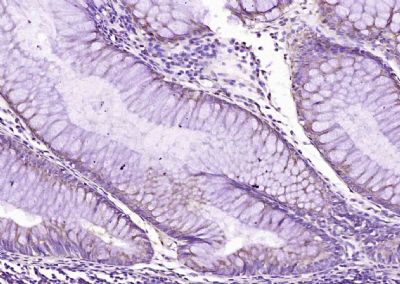HCN3 Polyclonal Antibody
Purified Rabbit Polyclonal Antibody (Pab)
- 产品详情
- 实验流程
Application
| IHC-P, IHC-F, IF, E |
|---|---|
| Primary Accession | Q9P1Z3 |
| Reactivity | Human |
| Predicted | Mouse, Rat, Rabbit, Horse |
| Host | Rabbit |
| Clonality | Polyclonal |
| Calculated MW | 86032 Da |
| Physical State | Liquid |
| Immunogen | KLH conjugated synthetic peptide derived from human HCN3 |
| Epitope Specificity | 51-150/774 |
| Isotype | IgG |
| Purity | affinity purified by Protein A |
| Buffer | 0.01M TBS (pH7.4) with 1% BSA, 0.02% Proclin300 and 50% Glycerol. |
| SUBCELLULAR LOCATION | Membrane; Multi-pass membrane protein. |
| SIMILARITY | Belongs to the potassium channel HCN family. Contains 1 cyclic nucleotide-binding domain. |
| SUBUNIT | The potassium channel is probably composed of a homo- or heterotetrameric complex of pore-forming subunits. |
| Important Note | This product as supplied is intended for research use only, not for use in human, therapeutic or diagnostic applications. |
| Background Descriptions | Hyperpolarization-activated, cyclic nucleotide-binding channels (HCN) are voltage-gated cation channels that are activated by direct binding of intracellular cyclic nucleotides. The HCN family consists of four members (HCN1-4), each with a core transmembrane segment domain and a C-terminal 120 amino-acid cyclic nucleotide-binding domain motif. HCN channels are expressed in the brain, heart, thalamus and testis. The pacemaker properties of HCN channels contribute to spontaneous rhythmic activity in the brain and heart. HCN3 contains a segment characterized by a series of positively charged amino acids at every third position. This region designated S4 is likely to be the voltage sensor of the protein. In the brain, HCN3 and HCN4 exhibit subcortical distribution mainly concentrated in the hypothalamus and thalamus, respectively. |
| Gene ID | 57657 |
|---|---|
| Other Names | Potassium/sodium hyperpolarization-activated cyclic nucleotide-gated channel 3, HCN3, KIAA1535 |
| Dilution | IHC-P=1:100-500,IHC-F=1:100-500,IF=1:50-200,ELISA=1:5000-10000 |
| Format | 0.01M TBS(pH7.4) with 1% BSA, 0.09% (W/V) sodium azide and 50% Glyce |
| Storage | Store at -20 °C for one year. Avoid repeated freeze/thaw cycles. When reconstituted in sterile pH 7.4 0.01M PBS or diluent of antibody the antibody is stable for at least two weeks at 2-4 °C. |
| Name | HCN3 |
|---|---|
| Synonyms | KIAA1535 |
| Function | Hyperpolarization-activated ion channel that are permeable to sodium and potassium ions, with an about 3:1 preference for potassium ions (PubMed:16043489). Contributes to the native pacemaker currents in heart (If) and in neurons (Ih). In particular, plays a pivotal role in maintaining excitability and promoting rhythmic burst firing within hypothalamic nuclei. Exerts a significant influence on the configuration of the cardiac action potential waveform. Does not appear to play a prominent role in the processing of acute, neuropathic, or inflammatory pain (By similarity). |
| Cellular Location | Cell membrane; Multi-pass membrane protein |
| Tissue Location | Detected in brain.. |
Research Areas
For Research Use Only. Not For Use In Diagnostic Procedures.
Application Protocols
Provided below are standard protocols that you may find useful for product applications.
终于等到您。ABCEPTA(百远生物)抗体产品。
点击下方“我要评价 ”按钮提交您的反馈信息,您的反馈和评价是我们最宝贵的财富之一,
我们将在1-3个工作日内处理您的反馈信息。
如有疑问,联系:0512-88856768 tech-china@abcepta.com.
¥ 1,500.00
Cat# AP59406























 癌症的基本特征包括细胞增殖、血管生成、迁移、凋亡逃避机制和细胞永生等。找到癌症发生过程中这些通路的关键标记物和对应的抗体用于检测至关重要。
癌症的基本特征包括细胞增殖、血管生成、迁移、凋亡逃避机制和细胞永生等。找到癌症发生过程中这些通路的关键标记物和对应的抗体用于检测至关重要。 为您推荐一个泛素化位点预测神器——泛素化分析工具,可以为您的蛋白的泛素化位点作出预测和评分。
为您推荐一个泛素化位点预测神器——泛素化分析工具,可以为您的蛋白的泛素化位点作出预测和评分。 细胞自噬受体图形绘图工具为你的蛋白的细胞受体结合位点作出预测和评分,识别结合到自噬通路中的蛋白是非常重要的,便于让我们理解自噬在正常生理、病理过程中的作用,如发育、细胞分化、神经退化性疾病、压力条件下、感染和癌症。
细胞自噬受体图形绘图工具为你的蛋白的细胞受体结合位点作出预测和评分,识别结合到自噬通路中的蛋白是非常重要的,便于让我们理解自噬在正常生理、病理过程中的作用,如发育、细胞分化、神经退化性疾病、压力条件下、感染和癌症。






